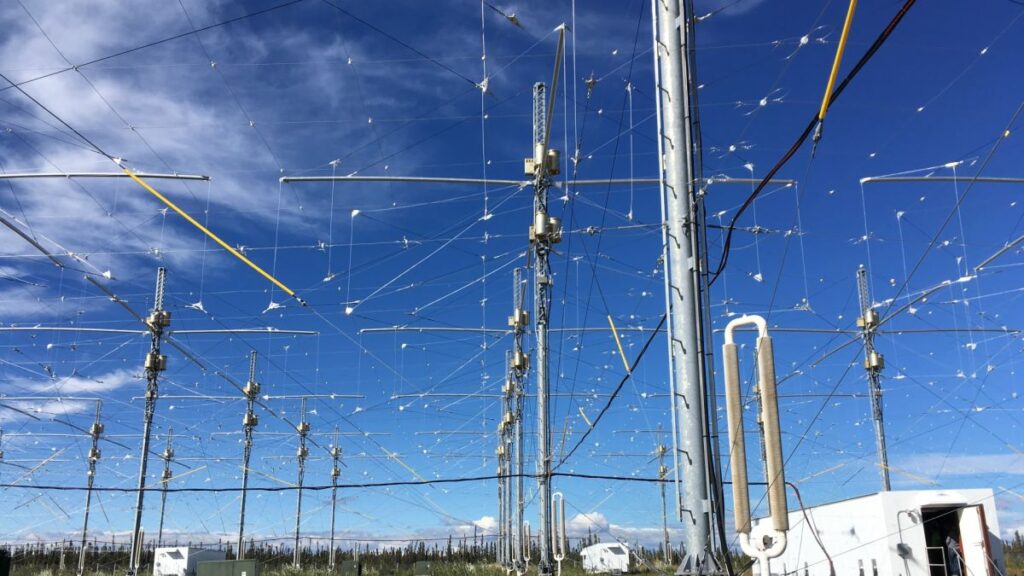By Brett Tingley
https://www.space.com/haarp-atmospheric-research-facility-bouncing-signals-jupiter-moon
HAARP’s current research program has been called ‘unprecedented.’
The High-frequency Active Auroral Research Program facility, or HAARP, is in the midst of a wide-ranging science campaign that will see the facility bounce signals off the moon and Jupiter.
HAARP consists of 180 antennas designed to transmit signals into the ionosphere, which stretches from 30 miles (48 kilometers) to 600 miles (965 km) above sea level and is seen as the area where Earth’s atmosphere meets space, according to NASA(opens in new tab). The ionosphere plays an important role in radio transmission, as it reflects radio waves. Many satellites occupy this region of the atmosphere, which is heavily influenced by solar weather.

HAARP is in the midst of a 10-day research campaign that is the facility’s “largest and most diverse to date,” HAARP program manager Jessica Matthews said in a statement(opens in new tab). Among the 13 experiments being conducted during the campaign are projects that will see signals bounced off the moon and Jupiter in order to test HAARP’s ability to study objects far from Earth.
One of the most ambitious experiments being carried out during HAARP’s current campaign is known as “Jupiter Bounce,” or “Interplanetary Ionosonde,” according to a statement from the University of Alaska Fairbanks (UAF)(opens in new tab). The experiment will test HAARP’s ability to bounce signals off the ionosphere of Jupiter, while also determining how well receivers at the University of New Mexico’s Long Wavelength Array can receive the reflected signals. The experiment is “the largest active remote sensing operation in history,” according to the UAF statement.
“This is a first-of-its-kind experiment (which) at least to my knowledge has never been attempted before,” HAARP research support services lead Evans Callis told Alaska Public Media(opens in new tab). “We transmit several different frequencies from HAARP directed at Jupiter. We listen for the echo that returns, and that should be able to tell us something about electromagnetic conditions around Jupiter.”
Another experiment, known as “Moon Bounce,” will see signals bounced off the moon back towards receivers in New Mexico and California. These signals will be evaluated for their use in determining the composition of near-Earth asteroids for future planetary defense purposes.
Meanwhile, HAARP’s “Making the Invisible Visible” experiment will “test if hot electrons are capable of producing the continuum (white) emissions present in STEVE airglow.” STEVE, short for Strong Thermal Emission Velocity Enhancement, is an aurora-like phenomenon that occurs when charged particles from the sun interact with Earth’s ionosphere.

“If we see that air glow and it matches the wavelength of light that we see from naturally occurring STEVE, that would give us indication that the hot electrons are playing some role in the formation of STEVE,” Callis said.
One of the more unique experiments, “Ghosts in the Airglow,” will mix art and atmospheric research to “play with the liminal boundaries of Earth’s atmosphere and outer space,” according to the project’s website(opens in new tab). The experiment will use HAARP to bounce images, spoken word and sound art off the ionosphere to learn more about radio propagation.
The HAARP facility was constructed in 1993 and originally operated by several United States military research agencies, including the Defense Advanced Research Projects Agency (DARPA), Air Force Research Laboratory and Office of Naval Research. In 2015, ownership of the facility was transferred to the UAF(opens in new tab).
While primarily used for upper-atmospheric research, the facility has been the subject of numerous conspiracy theories(opens in new tab) in the nearly three decades since it was constructed. Some have accused the U.S. government of using the facility to modify the weather, trigger earthquakes, create “chemtrails” or even to broadcast mind-control signals(opens in new tab).
To date, there has been no evidence of the facility being used for mind control or anything other than atmospheric research. According to the “Frequently Asked Questions” page on HAARP’s website(opens in new tab), “Neuroscience is a complex field of study carried out by medical professionals, not scientists and researchers at HAARP.”




